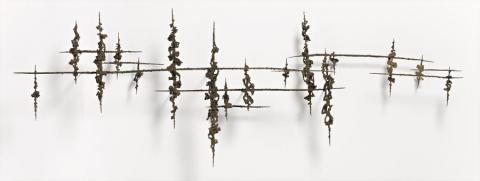UNTITLED (WALL SCULPTURE), c.1956
CLEMENT MEADMORE
welded steel
69.0 x 193.0 x 29.5 cm
The Crebbin Collection, Sydney
Thence by descent
Private collection, Sydney
Untitled, 1956, steel, private collection, illus. in Gibson, E., The Sculpture of Clement Meadmore, Hudson Hills Press, New York, 1994, p. 12
Born and educated in Melbourne, Clement Meadmore remains one of Australia's foremost expatriate sculptors. Studying Aeronautical Design and Industrial Design at RMIT, his original focus on furniture design led to a personal investigation into contemporary sculpture in the mid 1950s. The present work on offer is a rare, large scale wall-sculpture made in Melbourne during this important early period. As Eric Gibson, former Art Critic of the Washington (D.C.) Times, writes in his monograph on Meadmore, 'Prefiguring his later inclinations, Meadmore's first sculptures alternate between a rigorous geometry and a simmering expressionism ... They give no inkling that Meadmore is an artist who would eventually favour a robust physicality in his work. All, particularly the gridded rods, are as nearly diaphanous and self effacingly insubstantial as steel sculptures can be, as if Meadmore wished to suggest form not built up by accretion but eaten away by light.'1
These initial textural works gave way to heavier, grounded pieces composed of succinct visual forms that became the oversized public sculptures for which the artist is renowned. Yet, the central formal tenet is consistent; depicting metal mass as energised and balanced forms with a surprising quality of lightness. 'This sense of weightlessness is Meadmore's greatest achievement, especially in light of the substance and earth-bound demands of his materials ... It is the poetic lift and the unlikely defiance of their weighty materials that continues to intoxicate his admirers.2
1. Gibson, E., The Sculpture of Clement Meadmore, Hudson Hills Press, New York, 1994, p. 11
2. Gibson, P., 'Clement Meadmore: Nuanced notes and steady rhythms', Australian Art Review, Issue 24, August – October 2010, pp. 30–31
AMY MARJORAM
